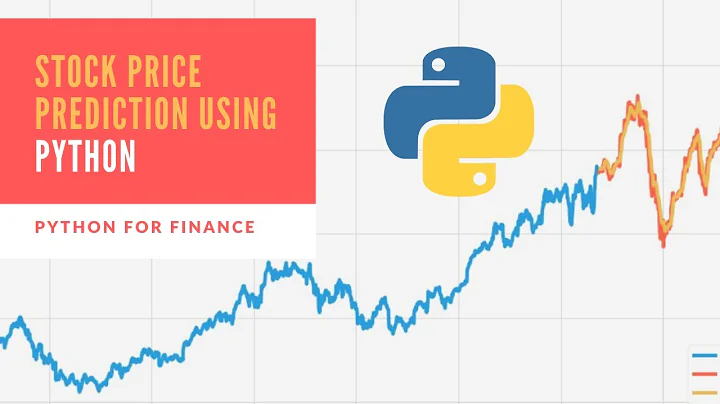Returning probabilities in a classification prediction in Keras?
Solution 1
So it turns out that the problem was I was not fully normalizing the data in the prediction script.
My prediction script should have had the following lines:
# these lines are copied from the example for loading MNIST data
(x_train, y_train), (x_test, y_test) = mnist.load_data()
x_train = x_train.reshape(60000, 784)
x_train = x_train.astype('float32') # this line was missing
x_train /= 255 # this line was missing too
Because the data was not cast to float, and divided by 255 (so it would be between 0 and 1), it was just showing up as 1s and 0s.
Solution 2
Keras predict indeed returns probabilities, and not classes.
Cannot reproduce your issue with my system configuration:
Python version 2.7.12
Tensorflow version 1.3.0
Keras version 2.0.9
Numpy version 1.13.3
Here is my prediction output for your x_slice with the loaded model (trained for 20 epochs, as in your code):
print(prev_model.predict(x_slice))
# Result:
[[ 1.00000000e+00 3.31656316e-37 1.07806675e-21 7.11765177e-30
2.48000320e-31 5.34837679e-28 3.12470132e-24 4.65175406e-27
8.66994134e-31 5.26426367e-24]
[ 0.00000000e+00 5.34361977e-30 3.91144999e-35 0.00000000e+00
1.00000000e+00 0.00000000e+00 1.05583665e-36 1.01395577e-29
0.00000000e+00 1.70868685e-29]
[ 3.99137559e-38 1.00000000e+00 1.76682222e-24 9.33333581e-31
3.99846307e-15 1.17745576e-24 1.87529709e-26 2.18951752e-20
3.57518280e-17 1.62027896e-28]
[ 6.48006586e-26 1.48974980e-17 5.60530329e-22 1.81973780e-14
9.12573406e-10 1.95987500e-14 8.08566866e-27 1.17901132e-12
7.33970447e-13 1.00000000e+00]
[ 2.01602060e-16 6.58242856e-14 1.00000000e+00 6.84244084e-09
1.19809885e-16 7.94907624e-14 3.10690434e-19 8.02848586e-12
4.68330721e-11 5.14736501e-15]
[ 2.31014903e-35 1.00000000e+00 6.02224725e-21 2.35928828e-23
7.50006509e-15 4.06930881e-22 1.13288827e-24 4.20440718e-17
4.95182972e-17 1.85492109e-18]
[ 0.00000000e+00 0.00000000e+00 0.00000000e+00 1.00000000e+00
0.00000000e+00 6.30200370e-27 0.00000000e+00 5.19937755e-33
1.63205659e-31 1.21508034e-20]
[ 1.44608573e-26 1.00000000e+00 1.78712268e-18 6.84598301e-19
1.30042071e-11 2.53873986e-14 5.83169942e-17 1.20201071e-12
2.21844570e-14 3.75015198e-15]
[ 0.00000000e+00 6.29184453e-34 9.22474943e-29 0.00000000e+00
1.00000000e+00 3.05067233e-34 1.43097161e-28 1.34234082e-29
4.28647272e-36 9.29760838e-34]
[ 4.68828449e-30 5.55172479e-20 3.26705529e-19 9.99999881e-01
3.49577992e-22 1.27715460e-11 4.99185615e-36 1.19164204e-20
4.21086124e-16 1.52631387e-07]]
I suspect some rounding issue when printing (or you have trained for much more epochs, and your probabilities for the training set have gotten very close to 1)...
To convince yourself that you indeed get probabilities and not class predictions, I suggest to try getting predictions from your model trained for a single epoch; normally you should see much less 1.0's - here is the case here for a model trained for epochs=1:
print(model.predict(x_slice))
# Result:
[[ 9.99916673e-01 5.36548761e-08 6.10747229e-05 8.21199933e-07
6.64725164e-08 6.78853041e-07 9.09637220e-06 4.56192402e-06
1.62688798e-06 5.23997733e-06]
[ 7.59836894e-07 1.78043920e-05 1.79073555e-04 2.95592145e-05
9.98031914e-01 1.75839632e-05 5.90557102e-06 1.27705920e-03
3.94643757e-06 4.36416740e-04]
[ 4.48473330e-08 9.99895334e-01 2.82608235e-05 5.33154832e-07
9.78453227e-06 1.58954310e-06 3.38150176e-06 5.26260410e-05
8.09341054e-06 3.28643267e-07]
[ 7.38236849e-07 4.80247072e-05 2.81726116e-05 4.77648537e-05
7.21933879e-03 2.52177160e-05 3.88786475e-07 3.56770557e-04
2.83472677e-04 9.91990149e-01]
[ 5.03611082e-05 2.69402866e-04 9.92011130e-01 4.68175858e-03
9.57477605e-05 4.26214538e-04 7.66683661e-05 7.05923303e-04
1.45670515e-03 2.26032615e-04]
[ 1.36330849e-10 9.99994516e-01 7.69141934e-07 1.44130311e-07
9.52201333e-07 1.45219332e-07 4.43408908e-07 6.93398249e-07
2.18685204e-06 1.50741769e-07]
[ 2.39427478e-09 3.75754922e-07 3.89349816e-06 9.99889374e-01
1.85837867e-09 1.16176770e-05 1.89989760e-11 3.12301523e-07
1.13220040e-05 8.29571582e-05]
[ 1.45760115e-08 9.99900222e-01 3.67058942e-06 4.04857201e-06
1.97999962e-05 7.85745397e-06 8.13850420e-06 1.87294081e-05
2.81870762e-05 9.38157609e-06]
[ 7.52560858e-09 8.84437856e-09 9.71140025e-07 5.20911703e-10
9.99986649e-01 3.12135370e-07 1.06521384e-05 1.25693066e-06
7.21853368e-08 5.21001624e-08]
[ 8.67672298e-08 2.17907742e-04 2.45352840e-06 9.95455265e-01
1.43749105e-06 1.51766278e-03 1.83744309e-08 3.83995541e-07
9.90309782e-05 2.70584645e-03]]
Related videos on Youtube
user9040452
Updated on July 10, 2022Comments
-
user9040452 almost 2 years
I am trying to make a simple proof-of-concept where I can see the probabilities of different classes for a given prediction.
However, everything I try seems to only output the predicted class, even though I am using a softmax activation. I am new to machine learning, so I'm not sure if I am making a simple mistake or if this is a feature not available in Keras.
I'm using Keras + TensorFlow. I have adapted one of the basic examples given by Keras for classifying the MNIST dataset.
My code below is exactly the same as the example, except for a few (commented) extra lines that exports the model to a local file.
'''Trains a simple deep NN on the MNIST dataset. Gets to 98.40% test accuracy after 20 epochs (there is *a lot* of margin for parameter tuning). 2 seconds per epoch on a K520 GPU. ''' from __future__ import print_function import keras from keras.datasets import mnist from keras.models import Sequential from keras.layers import Dense, Dropout from keras.optimizers import RMSprop import h5py # added import because it is required for model.save model_filepath = 'test_model.h5' # added filepath config batch_size = 128 num_classes = 10 epochs = 20 # the data, shuffled and split between train and test sets (x_train, y_train), (x_test, y_test) = mnist.load_data() x_train = x_train.reshape(60000, 784) x_test = x_test.reshape(10000, 784) x_train = x_train.astype('float32') x_test = x_test.astype('float32') x_train /= 255 x_test /= 255 print(x_train.shape[0], 'train samples') print(x_test.shape[0], 'test samples') # convert class vectors to binary class matrices y_train = keras.utils.to_categorical(y_train, num_classes) y_test = keras.utils.to_categorical(y_test, num_classes) model = Sequential() model.add(Dense(512, activation='relu', input_shape=(784,))) model.add(Dropout(0.2)) model.add(Dense(512, activation='relu')) model.add(Dropout(0.2)) model.add(Dense(num_classes, activation='softmax')) model.summary() model.compile(loss='categorical_crossentropy', optimizer=RMSprop(), metrics=['accuracy']) history = model.fit(x_train, y_train, batch_size=batch_size, epochs=epochs, verbose=1, validation_data=(x_test, y_test)) score = model.evaluate(x_test, y_test, verbose=0) print('Test loss:', score[0]) print('Test accuracy:', score[1]) model.save(model_filepath) # added saving model print('Model saved') # added logThen the second part of this is a simple script that should import the model, predict the class for some given data, and print out the probabilities for each class. (I am using the same mnist class included with the Keras codebase to make an example as simple as possible).
import keras from keras.datasets import mnist from keras.models import Sequential import keras.backend as K import numpy # loading model saved locally in test_model.h5 model_filepath = 'test_model.h5' prev_model = keras.models.load_model(model_filepath) # these lines are copied from the example for loading MNIST data (x_train, y_train), (x_test, y_test) = mnist.load_data() x_train = x_train.reshape(60000, 784) # for this example, I am only taking the first 10 images x_slice = x_train[slice(1, 11, 1)] # making the prediction prediction = prev_model.predict(x_slice) # logging each on a separate line for single_prediction in prediction: print(single_prediction)If I run the first script to export the model, then the second script to classify some examples, I get the following output:
[ 1. 0. 0. 0. 0. 0. 0. 0. 0. 0.] [ 0. 0. 0. 0. 1. 0. 0. 0. 0. 0.] [ 0. 1. 0. 0. 0. 0. 0. 0. 0. 0.] [ 0. 0. 0. 0. 0. 0. 0. 0. 0. 1.] [ 0. 0. 1. 0. 0. 0. 0. 0. 0. 0.] [ 0. 1. 0. 0. 0. 0. 0. 0. 0. 0.] [ 0. 0. 0. 1. 0. 0. 0. 0. 0. 0.] [ 0. 1. 0. 0. 0. 0. 0. 0. 0. 0.] [ 0. 0. 0. 0. 1. 0. 0. 0. 0. 0.] [ 0. 0. 0. 1. 0. 0. 0. 0. 0. 0.]This is great for seeing which class each is predicted to be, but what if I want to see the relative probabilities of each class for each example? I am looking for something more like this:
[ 0.94 0.01 0.02 0. 0. 0.01 0. 0.01 0.01 0.] [ 0. 0. 0. 0. 0.51 0. 0. 0. 0.49 0.] ...In other words, I need to know how sure each prediction is, not just the prediction itself. I thought seeing the relative probabilities was a part of using a softmax activation in the model, but I can't seem to find anything in the Keras documentation that would give me probabilities instead of the predicted answer. Am I making some kind of silly mistake, or is this feature not available?
-
desertnaut over 6 yearscannot reproduce your issue;
predictin my Keras 2.0.9 returns probabilities, as it should do
-
-
dzubke almost 3 yearsI ran into this same issue where I seemed to be getting classes instead of probabilities. I was using training generators for training which normalized my data automatically, but I was not normalizing my data when doing a custom inference call. Thanks for the help!








![[AI] Binary classification using tensorflow keras](https://i.ytimg.com/vi/PM6uvCLyeXM/hqdefault.jpg?sqp=-oaymwEcCOADEI4CSFXyq4qpAw4IARUAAIhCGAFwAcABBg==&rs=AOn4CLDKoPqOD8aPWFaKKsvL1tluauN7JQ)

